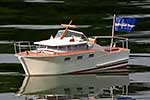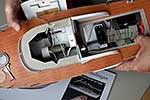If a ship model is meant to be floatable
If a ship model is meant to be floatable
The following instructions have been developed mainly for the model of the Titanic in the scale of 1:200 (no. 705). They must be adapted, wherever necessary, for other ship models that can also be made floatable: the TS Bremen (no. 688), the Chris Craft Futura (no. 71008) and the Barge (no. 721).
Plan ahead when constructing the hull and fit little tubes into the shaft bossing for the propeller shafts. Cut appropriate passages into the framework structure for the rudder mechanism. In addition, make additional cuts or holes at the bottom with a diameter of about 5 mm so that liquid epoxy resin can be poured in and each compartment can be reached.
In order to seal the hull and at the same time reinforce it, first spray on several very thin coats of varnish (using a spray). Please first test the spray thoroughly because some sprays make the material transparent or uneven. Always dry well between the coats.
Then reinforce the hull with thin glass fibre matting. Also make tests before using the glass fibre matting and epoxy resin.
Please note: The chemicals which are used here must NOT come into contact with skin or eyes. For this reason always wear protective clothing, gloves and goggles. It must also be taken into consideration that while working, heat can be created and in the extreme case can lead to the danger of fire. Children and adolescents should only be allowed to do this under supervision. It is also necessary to protect the work surface with foil.
In addition to the glass fibre matting (80 to 120 g/sqm and twill or atlas weave) and epoxy resin one also needs scales and an old soup dish for mixing, plus a cheap paint brush. The dish and brush have to be thrown away after the work has been done.
The epoxy resin ought to be as thin as water. The hardener ought to allow a pot life of at least 30 minutes. During this time the material can be worked with. Work at room temperature. The model should stand on the radiator to dry.
Cut the glass fibre matting to size and reckon with about 5 cm protrusion. Place the glass fibre in position. It has to lie properly. For example, cuts have to be made at the shaft bossing. Only now should you mix about 100 g resin with hardener using the brush, according to the instructions of the manufacturer. Carefully dab the resin on the fibre that lies on the hull. Put on just enough so that the fibre is soaked and glassy and sticks to the hull. If a gap occurs at one place, attach a bit of glass fibre. If you work very carefully, it won’t be visible later. Make sure that the glass fibre matting lies well at the edges and that it doesn’t detach itself anywhere. After about two or three hours, when the resin has hardened but is not yet brittle, cut of the protruding bits with household scissors. Later the synthetic resin can be sanded and polished with wet paper. If you want to reinforce more, you can add another layer of glass fibre as long as the fibre is still damp.
Now mix some more thin epoxy resin and paint the inside of the compartments in the hull with it. You can pour the resin through the holes into the inaccessible compartments at the bow and stern. By swinging the hull to and fro, all the parts can thus be reached.


